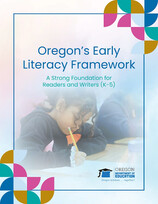 Juneteenth celebrates the date, June 19, 1865, when Union troops reached Galveston Bay, Texas, to inform the enslaved African-Americans there that they, along with the more than 250,000 other enslaved black people in the state, were freed by the Emancipation Proclamation. Even though the holiday occurs when most schools are on summer break, the events and symbolism of the holiday are important aspects of our nation's history and civic knowledge that students can explore in the final weeks of school or throughout the year when learning about civic holidays, civil rights, democracy and U.S. History.
Juneteenth Teaching Resources:
Freedom is in the Claiming (NYT 2020)
National Museum of African American History
10 Books for Adults, Teens, Kids to Celebrate Juneteenth
Learning for Justice Teaching Juneteenth
Gilder-Lehrman Juneteenth Lesson Plan
More ideas for teaching Juneteenth in K-5
Vox: Why all Americans should honor Juneteenth
TedEd Video (5min)

On May 30, the Oregon Department of Education (ODE) released the final version of Oregon’s Early Literacy Framework, a statewide resource document to fuel action and improve literacy proficiency for Oregon’s students. An overview of the framework is also available.
The framework provides coherence, clarity and common ground for high-quality, comprehensive early literacy education statewide. This resource elevates critical elements of comprehensive literacy instruction including fostering students’ sense of belonging in school, instruction grounded in the science of reading, culturally responsive teaching, and a focus on serving all students, inclusive of multilingual students, students experiencing disabilities, and students with dyslexia.
Oregon's Early Literacy Framework is informed by extensive literacy research, state literacy data, literacy frameworks in other states, consultation with literacy researchers, and conversations with practitioners and community partners. ODE included feedback from educators, literacy experts, and community members across Oregon, building from the preview draft released in March.
More about the Framework...
|
Last month, six school districts around the state passed bond measures that got a boost from the Oregon School Capital Improvement Matching (OSCIM) Program. Commitments are made to districts ahead of the election so districts can inform their communities of the potential for additional funds from the state if the local bond passes. Before submitting an application for the OSCIM Program, districts must also submit a Facilities Assessment and Long-Range Facility Plan. Districts are awarded grants based on their position on the Priority List or First in Time List.
Since the first round of grants in 2016, the OSCIM program has awarded more than $410 million in matching funds that added to $7.5 billion in bonds approved by voters. Here are the districts receiving matching funds following successful bond elections last month:

|